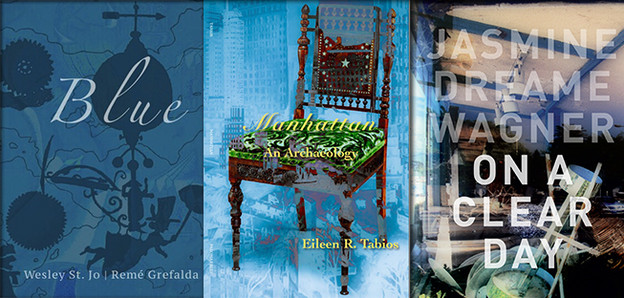
Cityscapes in verse
Brianne Alphonso

Jacket2’s summer intern, Brianne Alphonso, reviews three poetry titles that deal in cityscapes: On a Clear Day by Jasmine Dreame Wagner, Manhattan an Archaeology by Eileen R. Tabios, and Blue by Wesley St. Jo and Remé Grefalda.
On a Clear Day, Jasmine Dreame Wagner (Ahsahta Press, 2017)
Wagner’s book — a medley of prose, poems, and essays — tells a story of urban noise in an age where “visibility, consistency, solvency, become moral imperatives.” From the tapping of fingers on iPhone screens to the radio waves buzzing in our ears, the very air we breathe is loud. Lamenting the impossibility of originality as she navigates cityscapes, Wagner writes a commentary on what it means to be an artist in a world where the elegant silence of a sunset becomes a selfie on Instagram and people “cut and paste” sentiments repeatedly until the feeling is lost. The effortless shift from poetic form to plain speech in On a Clear Day matches our habit of bleeding together classic and pop culture.
Manhattan an Archaeology, Eileen R. Tabios (Paloma Press, 2017)
Though titled Manhattan, this collection is not about the city so much as the people who inhabit a “make-believe” location of cultural moshing. Tabios begins with an index of urban artifacts — a yoga mat, a piece of pineapple skin, a bottle of Seconal, a hundred-dollar bill — and follows this chain through the nuanced characters of her poetry. What we get in Manhattan an Archeology is a snapshot of faces: the privileged, the immigrants, the dead who still trudge to work, and the fluctuating smiles of the blissfully lost. The text explores “camouflage identity” in a place of amalgamation, where sense of self fractures and is pieced artificially together again. Tabios shifts her poetic form, dallying in prose and art, to create to create the “possibility instability promised-land of a huge city.”
Blue, Wesley St. Jo and Remé Grefalda (Paloma Press, 2017)
St. Jo and Grefalda excel in describing the nuance of a color: blue has a character of its own, from a blue sky to a blue visage, a blue parting and blue ink. The book reads not unlike a fairytale. Its lyrical verse and fantastical illustrations create a backdrop for discovery as well as longing. As a blue heart chases blue eyes, a story unfolds, and we cannot help but fall into its rhythm. Blue, “impractical blue — blue togetherness,” is not a long book, nor is it particularly complicated. But the bold brevity of the work enhances the sentiment present in each line. From the hesitance of “Should / I / Linger?” to the sureness of “lose you to a song? / absurd,” the poem has a way of drawing meaning from even the smallest of phrases. Blue may have only four letters, but it opens up to an entire world of thought.